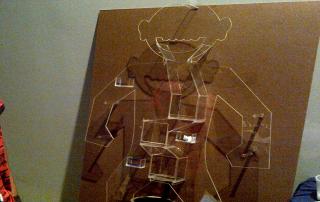Allison Berman
Blaire Moskowitz
Nelson Ramon
Feed Me!
Feed Me! is an interactive game in which participants are asked to help an on-screen avatar complete a challenge by virtually and physically feeding a life-size model various types of food.

Classes
Games and Play in Education
Games and Play in Education
Feed Me! is an interactive installation game in which participants are asked to help an avatar complete a challenge by virtually and physically feeding it different types of food. The game is intended to teach the basic working principles of the human digestive system including building and deconstructing objects which represent food.
Background
After significant research to refine our project plan, we did alpha testing with classmates. Next, we took the model to NYSci for phase one beta testing with middle school students and will return for a second round of beta testing this week. We tested the knowledge of the children pre- and post game play and monitored the amount of time the children played the game.
Audience
The intended audience comprises of middle school science students who are starting to learn complex scientific concepts. The New York State Department of Education’s Intermediate Level Science Core Curriculum (Grades 5-8) states that students should understand, “The digestive system consists of organs that are responsible for the mechanical and chemical breakdown of food. The breakdown process results in molecules that can be absorbed and transported to cells.” This guided experience is apt for middle school students because they are mature enough to make their own choices while performing the pre-written challenges that the game or educator has chosen, which correspond to their level of classroom learning.
User Scenario
Children will be presented with an avatar on a touch screen. The screen presents a nutritional challenge for the avatar to complete. The child will select the food that will complete the challenge and directions to build the food out of blocks will appear. Switching to the physical part of the game, the children will assemble a "food compound" and feed it to the accompanying model. Following instructions on the screen, they will take apart and put together new "compounds" in certain key spots on the doll, while watching watching the scientific information regarding that key spot of the digestive system. The usable parts of the compound will become muscle or another element that is needed for the challenge and the unneeded parts will be excrement.
Implementation
The 4x3 foot model is made of a plexiglass front and interior and a masonite backing. It is used in conjunction with a large touch screen (in an ideal setup) and accompanied by a workspace in which to build the plexiglass food compounds and a poster that introduces the basic ideology of the interactive.
Conclusion
We learned how to apply learning techniques and museum education methods to physically building the interactive installation. In addition, our beta testing with children presented a demographic in which we often create projects for, but rarely have a chance in which to interact. The ability to prototype the project multiple times and have child beta testers significantly informed our work.
Background
After significant research to refine our project plan, we did alpha testing with classmates. Next, we took the model to NYSci for phase one beta testing with middle school students and will return for a second round of beta testing this week. We tested the knowledge of the children pre- and post game play and monitored the amount of time the children played the game.
Audience
The intended audience comprises of middle school science students who are starting to learn complex scientific concepts. The New York State Department of Education’s Intermediate Level Science Core Curriculum (Grades 5-8) states that students should understand, “The digestive system consists of organs that are responsible for the mechanical and chemical breakdown of food. The breakdown process results in molecules that can be absorbed and transported to cells.” This guided experience is apt for middle school students because they are mature enough to make their own choices while performing the pre-written challenges that the game or educator has chosen, which correspond to their level of classroom learning.
User Scenario
Children will be presented with an avatar on a touch screen. The screen presents a nutritional challenge for the avatar to complete. The child will select the food that will complete the challenge and directions to build the food out of blocks will appear. Switching to the physical part of the game, the children will assemble a "food compound" and feed it to the accompanying model. Following instructions on the screen, they will take apart and put together new "compounds" in certain key spots on the doll, while watching watching the scientific information regarding that key spot of the digestive system. The usable parts of the compound will become muscle or another element that is needed for the challenge and the unneeded parts will be excrement.
Implementation
The 4x3 foot model is made of a plexiglass front and interior and a masonite backing. It is used in conjunction with a large touch screen (in an ideal setup) and accompanied by a workspace in which to build the plexiglass food compounds and a poster that introduces the basic ideology of the interactive.
Conclusion
We learned how to apply learning techniques and museum education methods to physically building the interactive installation. In addition, our beta testing with children presented a demographic in which we often create projects for, but rarely have a chance in which to interact. The ability to prototype the project multiple times and have child beta testers significantly informed our work.

